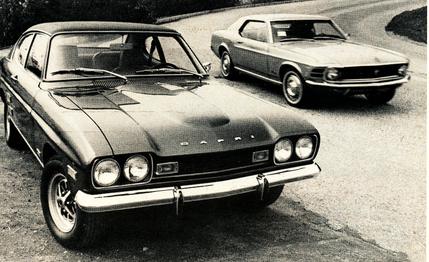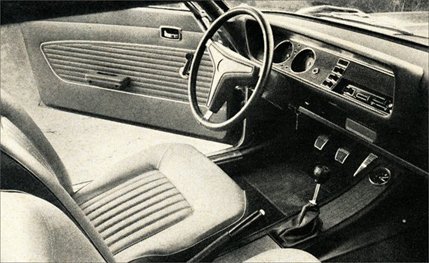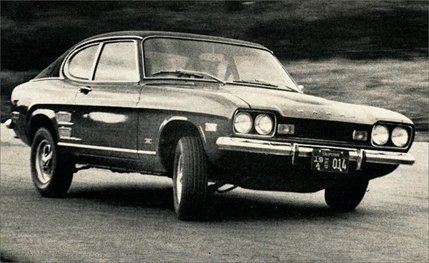
 Archived Road Test
Archived Road Test


In a nation that is sinfully proud to build ox carts, sidewinders and mobile wooden battle cruisers, Ford of England is an anomaly: It builds cars. It has not always been so and it is not absolutely true today; after all there is still the Corsair. But in recent years we have seen spewing out of Dagenham in huge numbers the likes of the Cortina (May, 1968) and the Escort. And now we have the Capri.
Of course. the Capri is not solely English. It is built, and in larger numbers, by Ford of Germany; and with the exception of the engine it is the German car which will come into this country as the Lincoln-Mercury Capri. But that is not to rule the English out: in good measure it is they who make the decisions—right down to asking that it he called the Cap-ri.
Having said that the Capri is the newest in a line of good cars let the bad part be recorded forthwith: The car is coming into the States with the wrong engine. The Capri is the first of the European cars to be built with a kind of American willingness to accept options, and options have been provided without end. There are two trim packages and 11 engines, six in the English version, five in the German. What is good for Europe should be good for the world: after all, the Capri is exported to 100 countries or more. But it is not the case. After carefully federalizing two engines, the 1600 will just have to do for American buyers.
It is a mistake. Although quoted at 71 hp, the so-called federal car is no better than the Beetle in performance, and all this from a $2295 car which looks like it would suck the doors off any of its competition.
What may be happening is that L-M has decided that the Capri is a sedan instead of the 2 plus 2 it very obviously seems to be. If so, they have company. Originally a two-seater, the car was lengthened to provide a 2+2 configuration in Europe, and at both Ford of England and Ford of Germany people are very careful to say it's neither a sedan nor a sports car.


All of this has obviously misled Lincoln-Mercury into thinking that what they had on their hands was just another kind of Maverick. Especially since the 200,000 sold in Europe have been sold in large numbers to the young, affluent, educated, often female—much the same words used in the market research on Ford's small cars.
What the Capri really is, or can be, at least, is a European sporty car, with looks and available performance to match. But not with the 1600, and that is something L-M will have to learn the hard way.
Moreover, the role suggested by the appearance is strongly reinforced by the way the Capri drives. The suspension is very stiff so that the car seems to follow precisely the road's undulations. deviating only in crossing a sharp bump, whereupon it seems to ski jump over the crest.
Of course the handling. or rather the handling you feel in street driving, benefits from this stiffness and the Capri feels very much like a racer. And the controls give the tactile sensations that will instantly elicit the racer in every driver—even the young, affluent and educated.
The steering is extremely light. Lighter than any front engine car we can think of, and it has excellent road feel. The same can be said for the shifter: very precise, good decent action so that the lever snaps into position and yet requiring very low effort. The driving position suffers from minimal thigh clearance between the steering wheel and the seat cushion. And there is little support for your throttle leg while all the time the shift lever seems unnecessarily far away.
Having modestly accepted the envious glances of the fickle public and noted how pleasant the car is on the street, the inevitable measurements have to be taken. And it is here that the Capri with the 1600 just doesn't stand up. The immoral, uncivilized and anti-social, standing quarter-mile takes 20.3 seconds to complete with a terminal speed of 66 mph—roughly equivalent, as we have said, to a stick-shift Beetle.
What is really objectionable is that the handling pales on the track, too. At moderate cornering rates, the car is very comfortable, but as you approach the limit it understeers vigorously and no amount of standing on the gas will swing the tail out.
The interior is neat and acceptably finished with two trim versions offered. The high line car includes such indispensables as a parking brake warning light and leather-covered steering wheel, but the standard version will do nicely—even without the vinyl roof. What both lack is acceptable instrumentation. In a car like the Capri a tack is indispensable and of course none is to be found. Both cars have back seats with fold-down armrests and two adults can fit back there quite comfortably if those in front aren't too greedy about legroom.


A final criticism concerns noise. The car we tested had a truck-like noise/vibration period at certain engine speeds that is unacceptable. With any luck it's not typical.
If Lincoln-Mercury is serious about selling the car as just another entry in the ... . . growing small car market" it will never realize the real potential of the car. There is a growing, market out there for cars that are different and, more importantly, cars with genuine all round performance. This the Capri is prepared to offer—given the higher output engine. With relatively light weight, 2080 lbs, a turning circle of 34 feet (steering ratio 17-1), a lovely gearbox and things like 185 x 13 radial tires (optional) and front discs standard, the car is essentially what the new wave of "performance" cars should be: lithe, lively, susceptible to driver inputs.
Right now, the car falls short, although there are elliptical remarks about higher Output engines in time. It is a fine automobile for single ladies, probably better than the Mustang or its brothers, an(] those who would normally buy a VW but want something more contemporary will find the Capri just right. But for genuine enthusiasts the federalized Capri is not quite there. That it can be is certain. Even as You read this, Jochen Neerspach is sitting in the competition department in Cologne directing an effort to win the European Touring Car Championship for Ford with the 1.3 liter car.
Now all L-M has to do is to bring that one in.